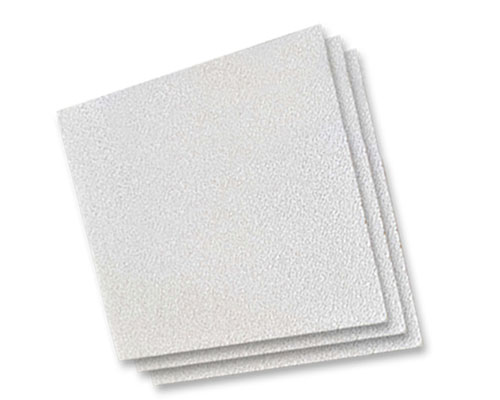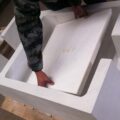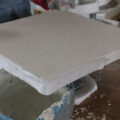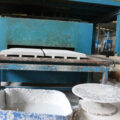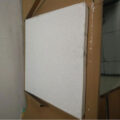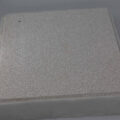In fact, molten metal, especially molten aluminum, often contains entrained solids, which are harmful to the final cast metal product. These entrained solids appear as inclusions in the final cast product after the molten metal is solidified, and cause the ductility of the final product to decrease or the smoothness and anodizing properties of the final product are poor. Inclusions may come from several sources. For example, inclusions may originate from a surface oxide film that is broken and entrained in the resulting molten metal. In addition, inclusions may come from insoluble impurities, such as carbides, borides, or corroded furnace and trough refractories. So, molten aluminium filtration for casting is necessary.
Naturally, there is a great need to design an improved filter for removing or reducing entrained solids from the final cast product, especially molten aluminium filtration for casting, especially when the resulting metal is used in decorative products, such as series of decorative edges or plates made of aluminum alloys, such as 5252 and 5657 aluminum alloys. Other aluminum alloys that benefit from improved filtration include aluminum capacitor foils made from 1000 series aluminum alloys, such as aluminum alloys 1145 and 1188. In order to reduce pinhole defects of light rail products and maximize rolling efficiency; high-strength extruded alloys, such as aluminum alloy 2024 and 7075, to obtain high ultrasonic quality; and 6000 series aluminum alloy extruded alloys, such as 6061 aluminum alloy, In order to obtain higher productivity in the extrusion operation.
The above-mentioned inclusions cause the performance loss of the final solidified alloy, and cause the reduction of processing efficiency and the loss of the performance of the final product. For example, one type of finish defect that is particularly important in decorative strips or plates made of aluminum alloy 5252 is a finer defect called a linear defect.
Strict melt processing processes (such as gas flux) minimize the incidence of such defects. However, these methods cannot successfully reduce them to a satisfactory level for critical applications. Conventionally, melt filtration is used to reduce the extent of such defects and other defects caused by inclusions in the melt. The most common form of melt filtration involves the use of an open woven glass cloth screen that is placed in a transfer and casting tank or in a molten metal pool on top of a solidified ingot. It has been found that such filters are only partially effective because they only remove larger inclusions. Another filter commonly used is, for example, a bed filter made of plate-shaped alumina. Such filters have many disadvantages, the most serious of which is the enormous difficulty encountered in controlling and maintaining the pore size necessary for effective filtration. Another difficulty with such filters is that they tend to produce poor initial quality metal at the beginning of each continuous casting run. This behavior leads to the so-called “butting effect” of ingots, that is, ingots with relatively poor quality butting parts must be discarded and recycled. Furthermore, even if no filter is used, the metal in the bed filter must remain molten.
Therefore, AdTech designed ceramic foam filter and molten aluminium filtration method for casting, which is particularly useful for filtering molten metal. A ceramic foam filter is very advantageous in filtering molten metal, especially molten aluminum, and is conveniently prepared at a reasonable cost. It does not contaminate the melt and does not cause the deterioration of the required characteristics in the final metal product.

